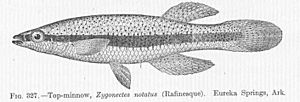Blackstripe topminnow facts for kids
Quick facts for kids Blackstripe topminnow |
|
|---|---|
 |
|
| Conservation status | |
| Scientific classification | |
| Genus: |
Fundulus
|
| Species: |
notatus
|
| Synonyms | |
The blackstripe topminnow (Fundulus notatus) is a small freshwater fish. It belongs to the family Fundulidae. You can find this fish in central North America.
Contents
Where Blackstripe Topminnows Live
Blackstripe topminnows live in different places across North America. In Canada, they are found along a 60-kilometer part of Ontario's Sydenham River. People only discovered them there in 1972!
In the United States, these fish live in the southern parts of the Erie and Michigan lake areas. They also live in the Mississippi drainage basin. This area stretches from Illinois all the way down to the Gulf of Mexico. Even though they are tough fish, human activities can change their homes and cause problems for them.
What Blackstripe Topminnows Look Like
The blackstripe topminnow gets its name from a dark stripe. This stripe runs along its side from head to tail. The fish has a small mouth that points slightly upwards. Its head is flat on top and has a colorful spot.
Most blackstripe topminnows grow to be about 5 to 7 centimeters long. That's about the length of your finger!
Males and females look different from each other:
- Males have dark vertical bars above and below their main stripe. Their fins are yellowish. Their dorsal (top) and anal (bottom) fins are longer and more pointed.
- Females do not have these vertical bars. Their fins are white. Their dorsal and anal fins are shorter and more rounded.
Life Cycle and Habits
Blackstripe topminnows usually live for about two to three years. They like to live in water that moves slowly. They prefer places with lots of plants along the river banks. These plants offer good hiding spots.
In the summer, they often stay near the water's surface. They eat insects that land on the water. They also eat insect larvae (baby insects) that live in the water. Other foods include tiny molluscs, spiders, and small crustaceans. When winter comes, they move to deeper water to stay warm.
How Blackstripe Topminnows Reproduce
Blackstripe topminnows lay eggs between May and August. This is called spawning. A female fish lays 20 to 30 eggs. The male fish then fertilizes these eggs. He carefully places each egg, one by one, into underwater plants.
Protecting Blackstripe Topminnows
Even though the number of blackstripe topminnows in Canada has stayed steady, they still face dangers. These fish need water plants and plants along the banks to survive. These plants provide food (insects) for them.
Some things that can harm their habitat include:
- Livestock: Farm animals like cows can walk through the riverbanks. This can destroy the plants the fish need.
- Wetland drainage: When wetlands are drained, the flow of creeks and streams can change. This might hurt the fish populations.
- Water use: Taking too much water from rivers for farming, especially during dry times, can lower water levels. This makes it hard for the fish to live.
- Oil spills: Oil from boats or equipment can get into the water. Since these fish feed at the surface, they could be harmed by oil slicks.
The blackstripe topminnow is listed as a species of Special Concern in Canada. This means it needs extra protection. The COSEWIC (Committee on the Status of Endangered Wildlife in Canada) first listed it in 1985. They re-checked and confirmed its status in 2001 and 2012.
Now, the blackstripe topminnow is protected under Canada's federal Species at Risk Act (SARA). Also, the federal Fisheries Act stops people from destroying fish homes. The blackstripe topminnow is part of a bigger plan to make the Sydenham River's ecosystem healthy again. This plan, started in 2003, was the first in Canada to protect water species by looking at the whole ecosystem.
See also
In Spanish: Fundulus notatus para niños


